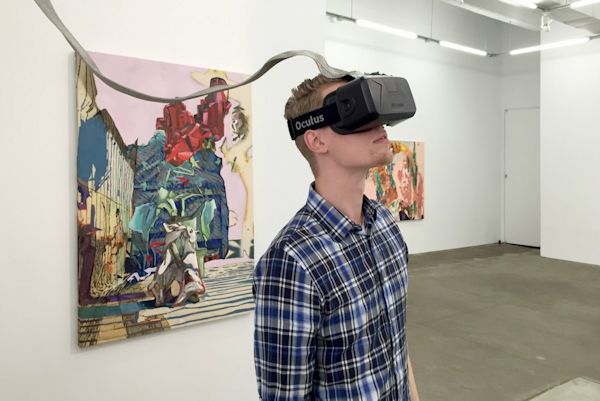[Rachel Rossin’s art goes beyond just using VR as it addresses the merging of the ‘real’ and virtual worlds; this is from PSFK, where the story includes more pictures. See Rossin’s website for more VR-based art. –Matthew]
Oil Meets Virtual Reality In This Trippy Painting Series
Rachel Rossin mixes the traditional with the digital by using a VR headset and visually intricate oil paintings
Eva Recinos
3 december 2015
Walking into an art gallery means surrendering yourself to whatever visuals might be on display against the space’s white walls. You negotiate space as you walk through an exhibition and take in each piece. But what happens when virtual reality is added into the mix?
Visitors to the Zieher Smith & Horton gallery in October and November got a bit of a surprise when they walked into the gallery to see virtual reality headsets displayed alongside the oil paintings of artist Rachel Rossin. For “Lossy,” she created a series of paintings whose visual fields were warped by technology. In one self-portrait, she took a 3D-scanned capture of her face and tinkered with the gravity aspect of the image to create something new.
In addition to the colorful, abstract works, viewers could see manifestations of Rossin’s aesthetic in virtual reality. When they put on the headsets, they could walk through a distorted view of the artist’s apartment.
Rossin finds it interesting to juxtapose reality with virtual spaces and see what happens in the process. But often, she finds the two realms are not as different as they might seem.
“We’re already living in a degree virtual reality with our experience being enmeshed with the majority of what makes us human transacting on screens (i.e. most of our social interactions),” wrote Rossin in an email.
For Rossin, virtual reality—in its most basic sense, sans the need for a headset—always felt “more safe.” Something about the virtual world felt “much more like home than real life.”
Rossin bridges the real and the virtual not only in the juxtaposition of mediums—the very real and traditional, tangible nature of oil paint meets the intangible visions seen in the virtual reality headset—but also in the display of her actual home and her artistic imagination.
For the exhibition, the artist captured images of her apartment and warped them to create a three-dimensional experience. That virtual space then informed the paintings Rossin created.
“It’s like the paintings and their virtual counterparts act as tethers for each other,” wrote Rossin.
Artists continue to incorporate technology into their work, including virtual reality. San Francisco’s Gray Area Foundation for the Arts hosted an exhibition where artists used the app Tilt Brush to create works in virtual reality. The works in progress were projected onto a screen so viewers could see what the artists were creating. In Los Angeles, artist Gretchen Andrew created an exhibition with only a few physical paintings; when the viewer put on a VR headset, they could see other paintings and a few easter eggs.
In her own work, Rossin creates a “feedback loop” in which the physical world and digital tools meet to create something new in both the virtual and tangible realms.
“I relished the contrast of this process: the digital alchemy of virtual reality against the primitive pushing of paint,” wrote Rossin.
